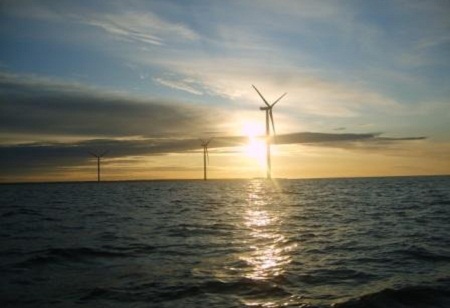Like the United States, Canada has gotten nowhere in developing offshore wind power, even as Europe reaps massive amounts of energy from the sea. A project planned for Lake Ontario is aiming to become Canada’s first offshore wind farm, and the company leading the effort has just brought on Siemens to supply turbines [PDF] and signed up a roster of contractors. But as with the long-planned, much-disputed Cape Wind development off Massachusetts, Windstream Energy’s 130-turbine, 300-megawatt (MW) Wolfe Island Shoals project is encountering big hurdles.
For instance, there’s the not-so-small matter of the province of Ontario’s moratorium on offshore wind. The government enacted the moratorium in February 2011, saying more research was needed on the potential environmental impact of offshore wind development on freshwater lakes.

“The recently installed Lake Vanern pilot project (pictured above) in Sweden is one of the only operational freshwater offshore projects in the world and a pilot project has been proposed in Ohio,” the Ministry of Environment said. “Ontario will monitor these projects and the resulting scientific knowledge. Ontario will work with our U.S. neighbours on research to ensure any future proposed projects protect the environment on both sides of the Great Lakes.”
In its announcement of the Siemens deal, Windstream noted that it “holds the only offshore wind power feed-in-tariff (FIT) contract in the province of Ontario, which was awarded by the Ontario Power Authority in May 2010.” But with the moratorium in place, that doesn’t count for much – to the company’s apparent frustration. Windstream President Ian Baines told the Hamilton (Ont.) Spectator he saw the FIT as a binding contract and suggested the project – at full scale – could be just the sort of study the province needs to get a better understanding off offshore wind on freshwater lakes.
The Wolfe Shoals Island project is planned for 48,000 acres of shallow water shoals a few miles off the southwest shore of Wolfe Island in the far eastern corner of Lake Ontario.
In its campaign to overturn the moratorium and get the project moving, Windstream is promoting the economic benefits that construction would bring – an average of 1,900 jobs over a five-year construction period, plus 175 permanent jobs once the project is completed, according to a report the company commissioned [PDF]. Windstream and Siemens noted that their turbine deal calls for the rotor blades for the 2.3-MW turbines to be manufactured in Tillsonburg, Ontario, meeting the Ontario FIT requirement that the project have at least 50 percent local content.

In late 2011, a consortium of companies organized the Lake Ontario Offshore Network to advocate for wind development on the lake, and the cities of Kingston and Hamilton have registered support for the offshore project, according to the group [PDF].
Still, there is opposition, and the announcement of the deal with Siemens brought a post and a flurry of comments to the Ontario Wind Resistance blog, with many commenters suspicious that the Ontario government was about to end the moratorium. Wind projects in general in Ontario have faced some opposition, although it is always difficult to know how pervasive the opposition really is. Last month, the government tried to put to rest allegations of adverse health effects citing a new study that it said “concluded there is no direct health risk from wind turbine sound at Ontario’s regulated setback distance.”